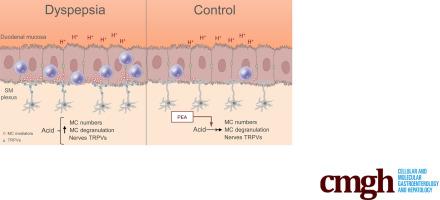Cellular and Molecular Gastroenterology and Hepatology ( IF 7.1 ) Pub Date : 2020-10-14 , DOI: 10.1016/j.jcmgh.2020.10.001 Giovanni Sarnelli 1 , Marcella Pesce 2 , Luisa Seguella 3 , Jie Lu 4 , Eleonora Efficie 2 , Jan Tack 5 , Fatima Domenica Elisa De Palma 6 , Alessandra D'Alessandro 2 , Giuseppe Esposito 3

|
Background & Aims
Acid hypersensitivity is claimed to be a symptomatic trigger in functional dyspepsia (FD); however, the neuroimmune pathway(s) and the mediators involved in this process have not been investigated systematically. Palmitoylethanolamide (PEA) is an endogenous compound, able to modulate nociception and inflammation, but its role in FD has not been assessed.
Methods
Duodenal biopsy specimens from FD and control subjects, and peroxisome proliferator-activated receptor-α (PPARα) null mice were cultured at a pH of 3.0 and 7.4. Mast cell (MC) number, the release of their mediators, and the expression of transient receptor potential vanilloid receptor (TRPV)1 and TRPV4, were evaluated. All measurements also were performed in the presence of a selective blocker of neuronal action potential (tetradotoxin). FD and control biopsy specimens in acidified medium also were incubated in the presence of different PEA concentrations, alone or combined with a selective PPARα or PPAR-γ antagonist.
Results
An acid-induced increase in MC density and the release of their mediators were observed in both dyspeptic patients and controls; however, this response was amplified significantly in FD. This effect was mediated by submucosal nerve fibers and up-regulation of TRPV1 and TRPV4 receptors because pretreatment with tetradotoxin significantly reduced MC infiltration. The acid-induced endogenous release of PEA was impaired in FD and its exogenous administration counteracts MC activation and TRPV up-regulation.
Conclusions
Duodenal acid exposure initiates a cascade of neuronal-mediated events culminating in MC activation and TRPV overexpression. These phenomena are consequences of an impaired release of endogenous PEA. PEA might be regarded as an attractive therapeutic strategy for the treatment of FD.
中文翻译:

十二指肠棕榈酰乙醇酰胺释放受损是功能性消化不良中酸诱导肥大细胞活化的基础
背景与目标
酸超敏反应被认为是功能性消化不良 (FD) 的症状诱因;然而,尚未系统地研究神经免疫通路和参与该过程的介质。棕榈酰乙醇酰胺 (PEA) 是一种内源性化合物,能够调节伤害感受和炎症,但尚未评估其在 FD 中的作用。
方法
在 3.0 和 7.4 的 pH 值下培养来自 FD 和对照受试者以及过氧化物酶体增殖物激活受体-α (PPARα) 无效小鼠的十二指肠活检标本。评估了肥大细胞 (MC) 数量、其介质的释放以及瞬时受体电位香草素受体 (TRPV)1 和 TRPV4 的表达。所有测量也是在神经元动作电位的选择性阻滞剂(四毒毒素)存在的情况下进行的。酸化培养基中的 FD 和对照活检标本也在不同 PEA 浓度存在下单独或与选择性 PPARα 或 PPAR-γ 拮抗剂组合进行孵育。
结果
在消化不良患者和对照组中均观察到酸诱导的 MC 密度增加及其介质的释放;然而,这种反应在 FD 中被显着放大。这种作用是由粘膜下神经纤维和 TRPV1 和 TRPV4 受体的上调介导的,因为用四毒毒素预处理显着减少了 MC 浸润。酸诱导的 PEA 内源性释放在 FD 中受损,其外源性给药抵消了 MC 激活和 TRPV 上调。
结论
十二指肠酸暴露引发一系列神经元介导的事件,最终导致 MC 激活和 TRPV 过表达。这些现象是内源性 PEA 释放受损的结果。PEA 可能被视为治疗 FD 的一种有吸引力的治疗策略。











































 京公网安备 11010802027423号
京公网安备 11010802027423号